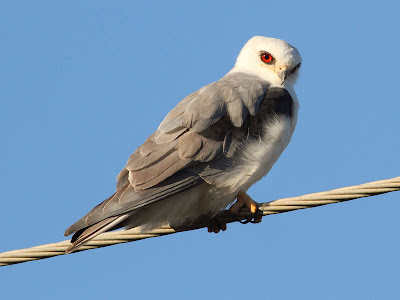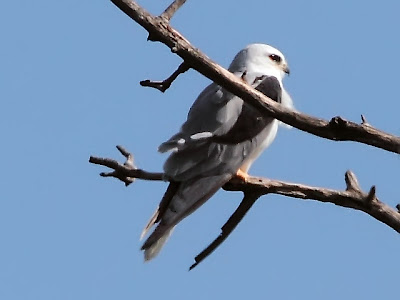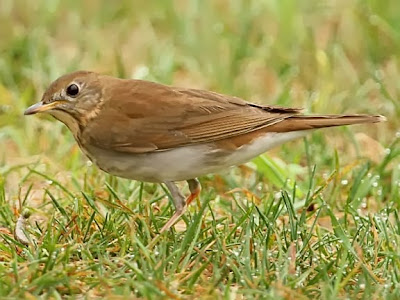The yellow-rumped warbler is a mid-sized warbler found in North and Central America. They get their name from the bright yellow rump patch that is located at the base of the tail. This patch has also the reason for their nickname, "Butter Butt". They also have yellow on their heads and yellow patches on their sides. Males are usually a striking contrast of black and white, while females tend to be more brown.
Yellow-rumps are expert foragers. They primarily eat insects which they glean from trees, males typically foraging higher in the trees then females. They will also catch insects on the wing, flying out from the branches that they have been gleaning from like a flycatcher. When there are no insects around yellow-rums will eat seeds and berries. They are the only species of warbler that can digest bayberries and wax myrtles. Because of this they are able to winter further north then other warbler species. Which is why they are usually the first warbler species that we see in spring and the last to leave in the fall.
There are four different variations of yellow-rumped warblers. Two of the forms are non-migratory. They are the Black-fronted, from north western Mexico, and the Goldman's from Guatemala. The other two forms are migratory. They are the Myrtle (top 2 photos), which breed in eastern Canada and parts of the northern United States, and the Audubon (last photo) Which breed in western Canada, Alaska, the Pacific Coast, and Rocky Mountains. Both forms winter in the southern United States, Mexico, Central America and the Caribbean.
Tuesday, December 31, 2013
Wednesday, December 25, 2013
Tuesday, December 17, 2013
White-tailed Kite
The white-tailed kite is a medium sized raptor that is found along the west coast of the United States, southern Florida, Mexico, Central and South America. They were at one time, grouped together with the European black-winged kite as a single species called the black-shouldered kite. However because of differences in size and behavior the species was divided into the white-tailed kite, in the Americas, The black-winged kite, in Europe and Africa, and the black-shouldered kite, in Australia.
The first white-tailed kites that we spotted, and photographed, where at the Elkhorn Slough National Estuarine Research Reserve near Monterey Bay in California. White-tailed kites were almost extricated from California by 1940 due to hunting and egg collecting. Preservation laws, like the Migratory Bird Act, gave protection to native species of birds and their eggs. This includes the white-tailed kite which, I am happy to say, are now common again in many parts of California. These first two pictures where taken in southern Texas where white-tailed kites can also be found.
Their preferred habitat is open country, such as grass savannas, marshes, desert grasslands and farm fields, where they hunt primarily small rodents. In 2012 while I was out photographing at Crex Meadows in Wisconsin I was surprised to spot a perched white-tailed kite. Now Crex meadows is perfect habitat for white-tailed kites, however it is way out of their normal range. This was only the third time on record that a white-tailed kite had been observed in Wisconsin. Now the winter of 2011 -2012 was unseasonably warm and lacking in snow which might explain why this bird was in Wisconsin. The have been known to venture far from their range and have been spotted as far away as New England. It was still exciting though and people came from all around to get a glimpse, especially since the last sighting in Wisconsin was over 10 years before.Tuesday, December 10, 2013
Veery
The very is a member of the thrush family that breeds in the swampy forests of the northern United States and southern Canada. They are much less common then the American thrush, otherwise known as the American robin. They are a spotted thrush but have less spots then other species of spotted thrush. As an insect eater they do not hang around on their breeding grounds during the winter. Instead they migrate down to the northern and central portions of South America, primarily Brazil. Like most passerines they migrate at night and can travel distances up to 160 miles per night.
Tuesday, December 3, 2013
Unfortunate!
As an environmentalist I am happy that small steps have been made to transition our energy needs to cleaner sustainable sources. New sources like wind, solar and wave technologies lessen our dependency on sources like coal, oil, natural gas, and nuclear. These older technologies pollute the environment and can be very dangerous.
Unfortunately good intentions can sometimes have bad side effects. That has been the case with wind energy. A study by the Us Fish and Wildlife Service reports that at least 85 golden and bald eagles were killed at wind farms between 1997 and 2012. That may not sound like a huge number over 5 years, however the study relied mainly on volunteered reports of fatalities by the wind energy companies. So it is possible the number may be much higher. The study also did not include all US wind farms. The Altamont Pass Wind Resource Area in California was not included in the study. It is located in an area with a high population of golden eagles and may be responsible for as many deaths as reported in the study every year.
Most of the concern is about eagles but other types of raptors also collide with windmills. Raptors typically watch the ground when they fly because they are looking for food. By the time they notice the structure it is too late as the blades which can be spinning in excess of 150 mph create wind currents that can suck the birds in. Most of the deaths happen at older facilities. While the UFAWS report has sparked awareness on this issue from concerned citizens a 1 million dollar fine that was recently levied against a wind energy company in Montana has gotten the attention of the wind industry. Some Wind energy companies now hire people to do impact studies before building new farms. Unfortunately the best location for wind farms are often great habitat for eagles. Other technologies, such as radar that can turn of turbines when it detects an eagle in the area, are also helping us to create a cleaner environment while minimizing our impact on eagles and other birds of prey.
Labels:
ABC Wednesday,
bald eagle,
golden eagle,
Wild Bird Wednesday
Tuesday, November 26, 2013
Three-toed Woodpecker
The three-toed woodpecker are found in the boreal forests of North America, Europe and Asia. At one time they were considered one species but in 2003 the species was split into the American three-toed and Eurasian three-toad. The three-toed woodpecker breeds farther north then any other species of woodpecker. The American version is found through out Canada, Alaska, and the Rocky Mountains. Typically they stay on their territory year round foraging for the larva of bark and wood boring beetles. Unlike most other species of woodpeckers they find their prey by pealing the bark off of trees instead of boring holes into them.
The three-toed woodpecker gets its name because it is one of the only woodpecker species that has three toes on each foot instead of four. Other then the two varieties of three-toed only the black-backed woodpecker has three toes. The black-backed are also found in boreal forests, although they do not breed quite as far north. The black-backed is very similar in appearance to three-toed except as its name would suggest it has a black back where the three-toed woodpecker's back is mottled black and white. The top photo in the post is a three-toed where the second is a black back. As you can see they look very similar. These are both males which you can tell by the yellow crown on the top of their heads. The female three-toed woodpecker has a mottled black and white crown where the top of the female black-back's head is all black.
Monday, November 25, 2013
Orange Sulphur
The orange sulphur is a common yellow butterfly that can be found through out most of North America. They are very similar in appearance to the clouded sulphur when perched, as in the photo above. However when they open their wings the upper surface is more of an orange color where the clouded sulphur is yellow on the tops of their wings.
It is possible to tell the difference between male and females by looking at the black border on the upper side of the wings. With the male the border is solid black, like in the photos above, while the females have yellow spots in the border. Orange sulphurs larval host plant is alfalfa, clovers, and other legumes.
Tuesday, November 19, 2013
Snowy Owl
The snowy owl is a large species of owls found in the tundra of Alaska, Canada, Europe and Asia. They are the largest owl species, by weight, in North America and slightly smaller then the Eurasian eagle owls that are found through out much of Europe and Asia.
Snowy owls are white with varying amounts of black mixed in. Males are typically mostly white while females and young birds have more of a black and white mottling. The bird in the top photo appears to be a young bird while the one in the photo above is probably a mature male.
Snowy owls are white with varying amounts of black mixed in. Males are typically mostly white while females and young birds have more of a black and white mottling. The bird in the top photo appears to be a young bird while the one in the photo above is probably a mature male.
Snowy owls have thick feathers that completely their body including their feet and toes. This provides insulation that allows them to survive on their territory in the tundra year round. Unlike most species of owls snowies are primarily diurnal, active during the daytime. They eat rodents, primarily lemmings, and some birds, such as ptarmigan.
Occasionally during the winter there is a shortage of prey. This can be due to a crash in the prey base or a very successful year of raising young which increases the population. When this happens snowies may migrate south in search of food. Typically these are young birds who do not yet have an established teritory. Here in Minnesota we see snowy invasions every three to five years. When they come south the most common place that we see them is at the airport. The airport is similar to their natural habitat on the tundra. It is large and flat and usually has a good amount of rodents for the owls to hunt. As you can see by the above photo the planes do not seem to bother them much.Saturday, November 16, 2013
Pine Grosbeak
The pine Grosbeak is one of the largest members of the finch family, Fringlilidae. They are found in the boreal forests of Alaska, Canada, Rocky Mountains, and Eurasia. Most pine grosbeaks stay on territory year round but they will migrate south, into southern Canada and northern United States in North America, when there is a shortage of food. They eat seeds, fruit, tree buds and some insects.
Males and females are distinctive in color. The top photo here is a female while the red bird in the second photo is a male. They breed in coniferous forests, often building a cup shaped nest in the fork of a conifer tree. They are strongly territorial during the breeding season but during the winter they often feed in flocks, staying near trees with fruit until it has all been consumed. They are also not very wary of people and will come to feeders mostly to eat sunflower seeds. Tuesday, November 12, 2013
Roseate Spoonbill
The roseate spoonbill is one of six species of spoonbills found around the world. They are all a part of the Threskkiornithidae family which also includes ibises. According to DNA studies the roseate spoonbill, which is the only spoonbill in the Americas is most closely related to the yellow-billed spoonbill that is found in southeast Australia. It is believed that these two species evolved from a common offshoot of the ancestors of the other four species.
The roseate spoonbill is found primarily in tropical regions of South America and the Caribbean. There are also small numbers of this species that breed in North America. The North America birds breed along the Gulf Coast in southern Texas, Florida, and Louisiana. They seem to prefer fresh water habitats but are also found in coastal saltwater areas. They swing their odd shaped beak from side to side to sift through the water and silt on the bottom and forage for crustaceans, aquatic insects, frogs, and small fish. Their food provides the carotenoid pigments which give the birds their pinkish coloration.
The roseate spoonbill is found primarily in tropical regions of South America and the Caribbean. There are also small numbers of this species that breed in North America. The North America birds breed along the Gulf Coast in southern Texas, Florida, and Louisiana. They seem to prefer fresh water habitats but are also found in coastal saltwater areas. They swing their odd shaped beak from side to side to sift through the water and silt on the bottom and forage for crustaceans, aquatic insects, frogs, and small fish. Their food provides the carotenoid pigments which give the birds their pinkish coloration.
Sunday, November 10, 2013
Clay-colored Sparrow
The clay-colored sparrow is one of the most numerous songbirds found on the central plains of North America. They breed in central Canada and the north Central United States and winter primarily in Mexico. They breed in shrubland habitats. The breeding territory is smaller then most other species of sparrow because they forage away from their breeding territory. They forage on the ground and eat a variety of seeds, grasses, leaf buds, and insects.
Males typically come back to the same nesting territory each year but females usually choose a different territory and mate each year. Their nest is usually located on the lower branches of a bush near to the ground. Females build the nest, which is cup shaped, but males help by bringing nesting materials like twigs and grass. The eggs take a week and a half to two weeks to hatch. The chicks are born helpless and with out feathers. In 7-9 days after hatching they leave the nest. They are still not able to fly at this time but they will spend the next week on the ground in the bushes where they will be fed by their parents.
Labels:
Bird D'pot,
Camera Critters,
clay-colored sparrow
Wednesday, November 6, 2013
Subscribe to:
Comments (Atom)


















































